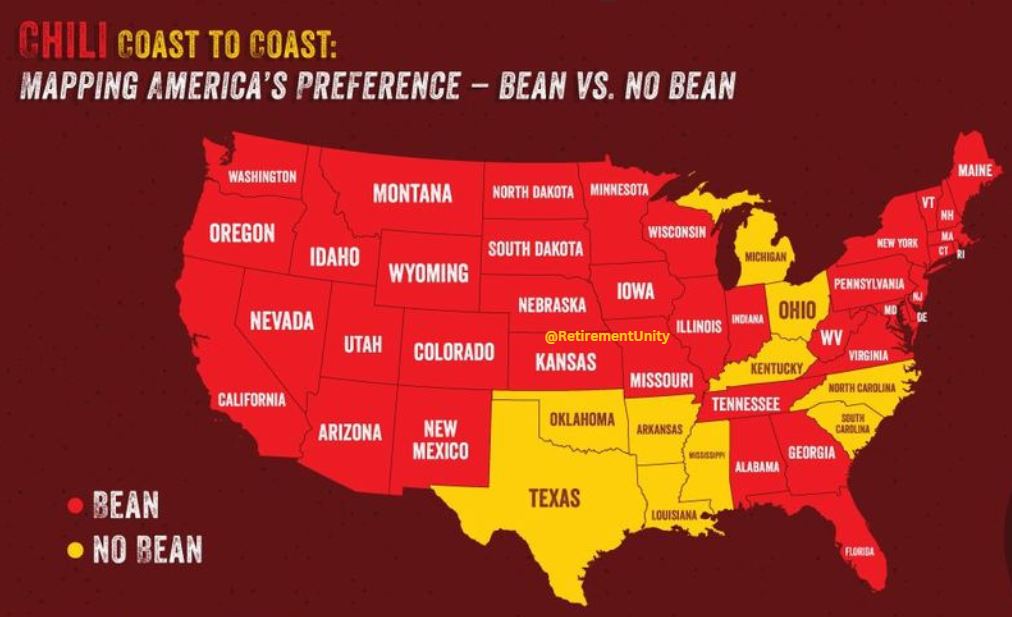NH Retirement Living By Region
Seacoast | Lakes Region | Merrimack Valley | Sunapee | White Mountains
The TikTok Incident: A Modern Discussion on Classic Comfort Foods
In the ever-evolving landscape of social media, where trends rise and fall with dizzying speed, there are certain topics that never fail to captivate audiences. Among them? The timeless debate over classic comfort foods, none more iconic than chili.
The Costco Beef Chili Announcement on Social Media
It all started innocuously with a social media post: Costco’s beloved beef chili was back on shelves. For aficionados of this comforting dish, it was cause for celebration—a chance to relish in nostalgia and savor flavors of yesteryears.
Yet, the announcement unexpectedly sparked a heated debate across digital platforms. As word spread, social media erupted with excitement, anticipation, and controversy.
Debate Over the Inclusion of Beans in Chili Recipes
At the heart of the controversy? The age-old question of beans in chili. For some, the very idea of beans in this beloved dish is anathema—a betrayal of tradition, a sacrilege against the culinary gods. To others, beans are not just an acceptable addition but an essential one, adding texture, flavor, and nutritional value to an already delicious dish.
As Costco’s beef chili took center stage in this culinary drama, the debate reached a fever pitch. TikTok, Instagram, Twitter—all became battlegrounds in the war of beans versus no beans, with passionate foodies and casual observers alike weighing in on the issue with gusto.
Conflicting Opinions from Users, Highlighting Generational Differences in Chili Preferences
The comments poured in by the thousands, each one offering a unique perspective on the age-old beans debate. On one side were the traditionalists, staunch defenders of the no-beans creed, who argued vehemently that true chili should be bean-free, full stop. “Beans have no place in chili,” they proclaimed, their words echoing across the digital landscape like a culinary manifesto.
Yet, amidst the cacophony of dissent, there were also voices of dissent—champions of innovation, proponents of progress. “Beans belong in chili,” they insisted, their arguments grounded in a belief that culinary traditions should evolve with the times, embracing new ingredients and flavors to reflect the changing tastes of a modern world.
But perhaps most fascinating of all were the generational differences that emerged in the debate. For older users, raised on a steady diet of classic chili recipes passed down through generations, the inclusion of beans was nothing short of heresy—a betrayal of everything they held dear about this quintessential comfort food.
Meanwhile, younger users, raised in an era of culinary experimentation and fusion cuisine, saw beans not as a threat to tradition but as an opportunity for innovation—a chance to put a new spin on an old favorite, to breathe new life into a dish that had long been considered sacrosanct.
As the debate raged on, one thing became abundantly clear: when it comes to chili, the only thing more heated than the dish itself is the debate over its ingredients. And in a world where opinions are as diverse as the people who hold them, perhaps that’s just as it should be.
The Texas Perspective: A Taste of Tradition
Iconic Texas Red Chili Tradition
In the Lone Star State, Texas Red chili holds a special place. It’s more than just a dish; it’s a cultural icon deeply ingrained in Texan identity. This chili tradition reflects the rugged individualism and frontier spirit of the region, echoing the Wild West’s essence. With its roots deeply intertwined with the Texan soil, Texas Red chili embodies the unapologetic flavor and rich heritage of the Lone Star State.
Texas-based Chefs’ Adherence to the No-Beans Stance and Its Historical Significance
In Texas, the tradition of Texas Red chili holds strong. It’s a culinary rule passed down through generations: no beans allowed. Purists believe beans dilute the chili’s essence, betraying its rugged flavor.
This stance isn’t just about taste—it’s about honoring Texas’s culinary heritage. It harkens back to cowboy traditions, where chili was cooked over campfires during cattle drives. For these chefs, the debate over beans is about preserving tradition and paying homage to Texas’s flavorful history.
The Role of Chili in Texan Culinary Culture and Its Connection to Heritage
Indeed, chili holds a special place in the hearts and minds of Texans, serving as a culinary touchstone that connects past and present, tradition and innovation. From humble beginnings on the trail to the pinnacle of modern cuisine, chili has remained a constant presence in Texan culinary culture, its flavors evolving with the times while its essence remains true to its roots.
For many Texans, chili is more than just a dish—it’s a symbol of community, camaraderie, and shared heritage. Whether enjoyed at a bustling cook-off, a family gathering, or a quiet dinner at home, chili brings people together in a celebration of flavor, tradition, and the indomitable spirit of the Lone Star State.
As Texas-based chefs continue to uphold the no-beans tradition and pass it down to future generations, they ensure that the legacy of Texas Red chili will endure for years to come—a testament to the enduring power of tradition, the timeless appeal of flavor, and the unbreakable bond between food and culture in the great state of Texas.
The Great Chili Bean VS No Bean Confrontation:
A Journey through Culinary History
The 1967 Chili Cook-off in Texas as a Pivotal Moment in Chili History
Step back in time to the year 1967, a momentous era in the annals of chili lore, where the stage was set for an epic showdown that would forever change the course of culinary history. Deep in the heart of Texas, amidst the sun-drenched plains and swirling dust of the Wild West, two culinary titans prepared to do battle in a contest of flavors, ingredients, and tradition.
The scene? A makeshift kitchen erected on the sun-baked plains, where judges—themselves seasoned chili connoisseurs—awaited the arrival of two intrepid contenders, each armed with nothing more than a stockpot and a fiercely-held belief in the righteousness of their chili recipe.
The Debate Between Beans-Inclusive and Beans-Exclusive Recipes
At the heart of this culinary clash lay the age-old question that has divided chili enthusiasts for generations: to bean or not to bean? On one side stood the champion of tradition, a stalwart defender of the no-beans creed, who believed fervently that the true essence of chili lay in its simplicity: beef, spices, and a rich, flavorful broth—no beans allowed.
Opposing him was the advocate for innovation, a maverick chef unafraid to challenge convention in pursuit of culinary excellence. Armed with a secret recipe passed down through generations, this culinary rebel saw beans not just as an acceptable addition but as a stroke of genius—a way to add depth, texture, and a touch of rustic charm to the dish.
As tensions reached a boiling point, the two contenders faced off in a battle of flavors, each determined to prove the superiority of their chili recipe once and for all. With every spoonful tasted, every debate waged, the very essence of chili hung in the balance, poised on the knife-edge of culinary history.
The Enduring Appeal of Chili and Its Ability to Bring People Together
In the end, a winner emerged, though not without controversy. The no-beans purist claimed victory, reaffirming the traditionalists’ faith in the sanctity of chili sans beans. Yet, even in defeat, the champion of innovation stood unbowed, his beans-inclusive recipe sparking a revolution in chili-making that would ripple through the culinary world for years to come.
But beyond the victor and the vanquished, the Great Chili Confrontation left behind a legacy that endures to this day. For in the fiery crucible of competition, where flavors clashed and passions ran high, chili emerged not just as a dish but as a symbol—a symbol of community, camaraderie, and the indomitable spirit of the Lone Star State.
And though the debate over beans may rage on, one thing remains abundantly clear: when it comes to chili, the only thing more powerful than the flavors themselves is the ability of this humble dish to bring people together in a celebration of flavor, tradition, and the timeless appeal of comfort food done right.
Celebrating the Comforts of Home
The Ongoing Debate Surrounding Chili Ingredients and Its Reflection of Changing Culinary Preferences
As the dust settles on the Great Chili Confrontation and the echoes of debate fade into the distance, one thing remains abundantly clear: the debate over chili ingredients is far from over. Across social media platforms, in kitchens and cook-offs, and around dinner tables, passionate foodies continue to grapple with the age-old question of beans versus no beans, tradition versus innovation.
But in the midst of this culinary clash of titans, a deeper truth emerges: the debate over chili ingredients is not just about beans or no beans, spices or broth—it’s about so much more. It’s a reflection of changing culinary preferences, evolving tastes, and the ever-shifting landscape of food culture in the modern world. As palates evolve and culinary boundaries blur, the definition of what constitutes “authentic” chili is open to interpretation, debate, and delicious experimentation.
The Timeless Appeal of Comfort Foods like Chili, Serving as a Reminder of Cherished Memories
Amidst ever-changing food trends, there’s a constant: comfort food. Chili, a humble yet satisfying dish, warms hearts across generations.
Chili holds a special place, evoking cherished memories and the comforts of home. Whether at a family gathering or a cozy night in, it brings people together.
As the chili debate rages and tastes evolve, let’s remember its timeless appeal. Let’s cherish the flavors of the past and embrace culinary adventures ahead. After all, whether with beans or without, chili is the epitome of home comfort.
 The Nostalgia and Comfort of Classic Dishes like Chili
The Nostalgia and Comfort of Classic Dishes like Chili










